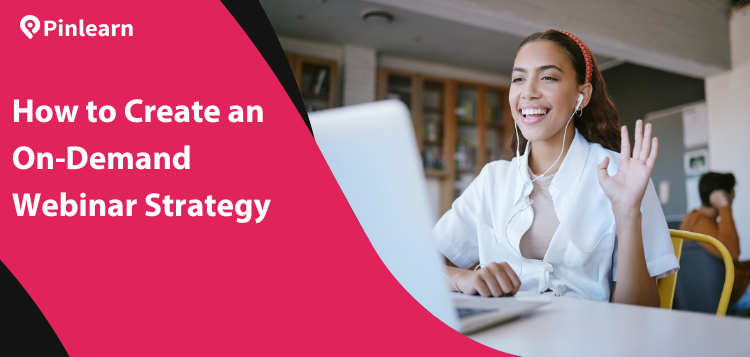How to Create an On-Demand Webinar Strategy?
Are you in search of evergreen, scalable strategies to grow your business? Then, on-demand webinar strategies could be your holy grail! After all, 47% of webinar views happen on-demand.
So, why not drive conversions from these numbers?
Webinar attendees have a higher likelihood of converting, since they already took the first step to attend your session. On-demand webinars are hosted and available all the time, further increasing the chances of conversions.
If you are excited by this idea and want to implement it in your business. We have covered everything on how to create an on-demand webinar strategy. From the basics to detailed steps and best practices — your ultimate growth hack is just a few clicks away!
What is an On-Demand Webinar and How is it Different From Live Webinars?
An on-demand webinar is a pre-recorded session that the audience can watch anytime. They can view the webinar content at their own convenience given the 24/7 availability. On the other hand, live webinars are scheduled at a specific date and time for access.
On-demand webinars are a great tool for creating an interaction with prospects. The important point is to find where the webinar fits in your buyer’s journey.
From educational series to product demos, on-demand webinars flip the business script to your advantage. While live webinars might score a bit higher on engagement, on-demand webinars are more cost-effective and show higher attendance.
What are the Benefits of On-Demand Webinars?
Here are some key reasons why an on-demand webinar might work for your business:
-
Wider Audience Reach
No matter how well you plan, “life throws you a curveball.” And, you miss out on your most-awaited live webinars! But on-demand webinars offer you flexibility. Your audience can access them as per their schedule across time zones. This significantly expands your content reach and life span.
-
Cost-Effective Lead Generation
Imagine the cost incurred with each live webinar. Hiring speakers, equipment costs, and last-minute edits and several unforeseen expenses that add to your bill. On the other hand, on-demand doesn’t cost you anything once it’s recorded. And you can use it for years down the line!
-
Content Repurposing
There is no dearth of ideas on repurposing your on-demand webinars. Think of blog posts, social media reels, or infographics to educate your audience.
-
High ROI
Once you have recorded and published your on-demand webinar, there’s no looking back. All you need to do is streamline the landing page, registration and broadcast process! Without much effort, see more viewers signing up and a compounding ROI that follows.
-
Collects Valuable Insights & Analytics
As on-demand webinars show higher attendance, you can collect more data and insights from the audience. Observe how long the audience watched your webinar, places where they paused, skipped, or revisited.
How to Create an On-Demand Webinar Strategy: 8 Easy Steps

Step # 1: Define the Goals and Objectives of Your Webinar and Understand Your Audience
The first step to deliver an impactful webinar is to visualize your goals and objectives. Why are you planning an on-demand webinar? Start by identifying your goals clearly.
Common on-demand webinar goals include:
- Increasing brand awareness
- Driving customer engagement
- Higher lead generation
- Demonstrating a product demo
- Building a loyal audience
A well-planned webinar ensures you’re heading in the right direction!
Also, it helps to measure the right metrics and engage your audience the right way. Number of registrations, attendance rate, engagement level, and conversion rate are key webinar metrics. And when you know how successful you are from the outset, you don’t lose focus!
Your target audience might include your potential customers, existing users, entrepreneurs, or corporate learning teams. Understanding your audience helps you choose the right topic for your webinar.
Step # 2: Decide the Format and Script of Your Webinar
Next, based on your goals and audience, choose the right format for your webinar.
Some popular on-demand webinar formats are:
- Informational or Educational Webinars: Here you can share knowledge, teach a skill and educate your audience. The goal is to build awareness, share insights and build authority. For example, an informative session on “Top AI trends in the learning industry.”
- Product Demos: This is a middle-of-the-funnel strategy. Here, your audience is about to purchase the product, and you’re giving them a brief walkthrough. For instance, a product demo on your newly launched course marketplace; explain the features, screenshots and include CTAs.
- Workshops & Step-by-Step Tutorials: Here, you showcase how to solve a problem using your product or service. Start with audience pain points and how your product solves them. For example, how your tutor scheduling software automates bookings, payments, and billing all in one place.
- Case Studies & Success Stories: This is best for late-stage buyers and conversion campaigns. You can show real-world scenarios where your product or service helped your customers. This builds trust and relationship with your audience!
- Expert Panel Discussions: Host expert panel interviews or debates on relevant industry topics and trends. For example, a brief talk on “How AI is redefining the e-learning industry.”
A standard template of a webinar includes: introduction, main content or body, Q&A session and conclusion. Add videos, infographics, polls, and interactive slides for engagement.
Step # 3: Choose the Webinar Software
While on-demand webinars need less preparation, choosing the right software is essential.
Often, the video quality and engagement of your webinar depend on the platform. Most webinar software offers both recording and hosting options. Consider your webinar goals, video quality, registration and replay gating, branding, and analytics to pick the right software.
Here are the popular webinar softwares and their features:
-
WebinarNinja
WebinarNinja supports live, automated and on-demand webinars. Offers a user-friendly interface and high engagement. Polls, quizzes, analytics, landing and registration page customization are its key features.
-
BigMarker
BigMarker is great for hosting large events and offers excellent on-demand capabilities. The software is preferred for its powerful video conferencing features and branding. Interactive tools include polls, surveys, and Q&A.
-
ClickMeeting
ClickMeeting is another browser-based webinar that supports live and on-demand webinars. It doesn’t need software installation and allows third-party integrations. Its key features include polls, Q&A, screen sharing, and whiteboards.
-
EverWebinar
EverWebinar is more suited for automated and evergreen webinars. It offers scheduling flexibility, powerful HD, real-time chats, and integrations. You can access advanced analytics that track attendance, performance, and conversions.
Step # 4: Plan Your Equipment
Aiming for an impactful webinar? Master these aspects — an interesting topic, valuable information, and an engaging audience.
But wait, are you missing out on a key aspect? A professional-quality video. Yes, a blurred and pixelated video often falls flat! Besides, your webinar quality also defines your brand credibility and the face of your business.
The following are the essentials for hosting a professional webinar:
- Stable, high-speed internet connection
- Decent laptop
- Laptop webcam/ External webcam/ Broadcast quality camera
- Microphone and headphones
- Natural Lighting or basic lighting setup
Test all your equipment & software before going live! This ensures a smooth experience and avoids any last-minute glitches.
Step # 5: Host and Record the Webinar
Lights, camera, and it’s time to record your video! If you’re going live for the first time, it’s perfectly fine to get nervous. A few rehearsals with your planned script, and you’ll be great once the camera rolls in!
Before you actually start your session, ensure you’re recording it!
You might have scheduled the session on a specific date & time. Start by welcoming all your attendees and introducing yourself. Next, bring your script to action!
Here’s a basic webinar flow to get things started:
- Welcome your attendees
- Introduce yourself, the speaker and the topic of discussion
- Include polls, questions, and activities to make the session interactive
- Manage the slides or presentations and Q&A
- Post-recording, trim the unnecessary sections, add graphics or background, and fix technical issues and add branding
Adobe Premiere Pro, DaVinci Resolve, and iMovie are popular editing tools. Also, you might need to remove background noise or adjust audio levels.
💡 Related: How to record an online course video?
Step # 6: Creating & Publishing Your Webinar
Once that is done, upload your live webinar as on-demand content. Now, to turn your webinar into on-demand content, follow the steps as per your webinar software.
If you have already hosted a live event, those who missed it can view it at their convenience. Set the webinar’s availability: either just-in-time scheduling or a recurring schedule. The recurring feature makes the webinar available at different slots. The participants can choose one based on their availability.
Step # 7: Build an On-Demand Funnel
An on-demand webinar is a 24/7 lead conversion machine. But your conversions depend on how well you integrate it into the buyer’s journey!
Here are the key elements for an effective on-demand webinar funnel:
-
Traffic Generation
This is the entry point of your audience into your funnel. Blogs, social media posts or YouTube snippets attract the right audience.
-
Landing Page
Your landing page should be a simple and concise copy. Include compelling headlines, key takeaways and teaser videos onto the page. Mention key speakers and add social proof, and CTAs to build credibility. Create a registration form to capture essential information from viewers.
-
CTA
An action-oriented CTA drives the number of sign-ups. For instance, “Book Now” or “Register Today” are effective CTAs for the landing page. Subsequently, add CTAs in between and at the end of the webinar as well. Think about CTAs like “Book a 15-minute demo”, “Sign up for a free trial” or “Sign up today to get 20% off”.
Here’s a simple webinar funnel:
Webinar Ad/ Social Media Post/ Blog -> Landing Page -> Registration -> Webinar Video -> End-of-the webinar CTA -> Booking or Offer -> Follow-up-> Tracking analytics
Perform A/B testing on different headlines, CTAs, and images to increase conversions.
Step # 8: Promote the Webinar
Most businesses make a big mistake. Promoting your webinar is always an afterthought!
They invest a lot of time and money in creating the webinar. But, unless you spread the word, no one is going to sign up for your webinar.
Here are some webinar marketing strategies to generate leads:
-
Email Marketing
With 57% webinar registrations, email marketing is one of the effective channels to reach your target audience.Build an email list with existing customers. Create email sequences and send invites with compelling headlines and CTAs. Don’t forget to segment your audience and send reminders to increase sign-ups.
-
Social Media
Social media promotions are great for increasing discoverability. It doesn’t matter whether you’re promoting on Instagram, Facebook, or LinkedIn. Create engaging social posts and share your webinar links to drive traffic. Run paid ads or bite-sized clips for targeted reach and quick conversions.
-
Blog
Create a blog post on your on-demand webinar to generate interest. This is a natural way to direct the audience to register. Use banners, pop-ups, and CTAs to link it to your webinar.
-
Podcast
Podcasts are transformative tools to build your brand. Most millennials consume podcasts today. So, why not turn your webinar into a compelling podcast episode? This increases its life span and reach!
Step # 9: Follow-Up & Engage with Your Audience
Once your leads attend your webinar session, your job isn’t over. They need some extra push to actually convert! That’s why you must engage with your audience. Nurture your leads, focus on building trust and building relationships.
Below are popular conversion strategies:
- Send a personalized thank-you note to attendees
- Share key webinar highlights, replays or resources
- Reminder emails for those who didn’t attend the sessions
- Ask for feedback or opinions on your webinar, slides, and presentation style
- Respond to specific questions, opinions or topic requests with straight answers
- Promote with attractive deals, events, new product launches, etc.
Your customers need this extra push to cover that last mile — from being your lead to customer!
Best Practices for Creating an On-Demand Webinar Strategy
1. Keep Your Webinar Short and Informative
With decreasing attention span, it’s great to keep your webinar short and sweet. A 30-minute duration is ideal to keep your participants engaged. This also ensures your audience doesn’t focus on and retain all the information.
2. Check Your Recording Permissions in Advance
You don’t want last-minute interruptions to play spoilsport. Enable permissions for webcam, audio, and hardware access for a smooth webinar experience.
3. Repurpose Your Webinars
Webinars are a versatile source of information, so don’t restrict them to one form. Maximize ROI by repurposing them as blogs, social media posts, reels, or even podcasts. You can easily transcribe them into blog posts, extract mini video clips or audio segments for podcasts.
4. Use Segmentation & Automate Funnels
Selling webinars needs a strategy — and segmentation. Great content needs to be delivered to the right people, at the right time and in the right way. Use marketing tools like HubSpot, MailChimp, Google Analytics and social media analytics to segment the audience. For instance, analyze the demographics and content that drives more engagement.
5. Tweak Strategies with Webinar Analytics
Use analytics to collect data from registration, webinar sessions, and attendance. Also, measure performance with key metrics like watch time, drop-offs, CTA clicks, and registration sources. This helps to optimize your content, fork out unnecessary costs, and personalize content.
Final Thoughts
On-demand webinars are a powerful tool for building your brand presence. Whether you host a knowledge-sharing session, a panel discussion, or a quick AMA session, they make a deep impact and connect with diverse audiences.
Besides, on-demand webinars are win-win for both marketers and customers. Businesses can ramp up their leads as these webinars are available 24/7. On the other hand, customers can view the webinar at their convenience without any scheduling.
We hope you got all the steps to build an on-demand webinar strategy. So, how will you include on-demand webinars to grow your business? Do leave a comment below!
FAQ-Related to How to Create an On-Demand Webinar Strategy
1. Can a webinar be on demand?
Yes, you can schedule on-demand webinars. Once you record a live webinar, upload it to the cloud. Next, create a landing page and registration process, and those who sign up can access the recording.
2. How much to charge for a 1-hour webinar?
Webinar prices can range from as low as $20 to over $200. The prices depend on several factors, such as the niche, goal, expertise, and positioning.
3. What are some effective ways to promote my on-demand webinar strategy?
Tried-and-tested promotional tactics for on-demand webinars are:
- Create a high-conversion landing page
- Include in blog posts
- Nurture with email sequences
- Social media marketing and retargeting
- Leverage paid ads & collaborations





